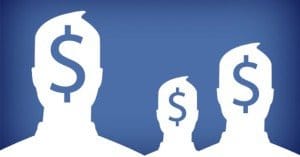 Written by ContentPowered.com
Written by ContentPowered.com
There’s a feature called frequency buried in the Facebook ad tracking options. If you’ve known about it before, you’ve likely kept it into consideration while optimizing your ads. If you haven’t heard of it, no, it’s not the audio frequency of Facebook’s constant subliminal advertising playing through your speakers. It’s also not the number of times you should post in a day. It’s the number of times, per day, that a given ad is shown to people on average. A frequency of 1 means that your ad was shown to everyone in your audience once that day. A frequency of 4 means everyone saw it four times. A frequency of .5 means that half of the audience saw your ad.
What frequency is the correct frequency? It’s impossible to say. Ideally, you don’t want a frequency less than 1. If it’s less than 1, you’re not reaching everyone you could reach, so your volume – and thus your conversions – are limited in a way they don’t have to be.
On the other hand, a frequency of greater than 4 would be detrimental to you, as your ad looks like spam because of how frequently it shows up. This is why Facebook has a hard limit; your frequency can reach a maximum of 4 for fans, and a maximum of 2 for non-fans.
“But I know I’ve seen the ad for X a dozen times in one day!” You say. Yes, that may be true. If you’re talking about the sidebar ad, there’s no frequency limit. These limitations are strictly for desktop/mobile news feed ads.
Limiting Frequency
Often, you may find that a frequency of 1 is better in terms of clicks and conversions than a frequency of 4. Up until just recently, there was only one real way of limiting your frequency; bidding less on your ad. The less money you pump into the ad, the lower the number of people who see it. The problem is, this requires fairly extensive testing to determine the right amount of money required to reach the right number of users in a given audience with a given post. You would have to test, split-test, optimize your keyword, audience and every other factor each time. It’s a time consuming process.
Facebook, thankfully, has made this all much simpler. You no longer need to worry about all that split testing and budget limiting. All you have to do is set the “optimize for” section to “daily unique reach.”
When you click for daily unique reach, you’re telling Facebook to use your ad budget to do the best it can to reach everyone in your audience exactly once. You’re not currently able to set that ad frequency any higher, so if you’ve found that showing your ads to your audience twice in a day is the most effective level, you might want to stay away from this option.
Additionally, Facebook will ask you to “Set the amount reaching 1,000 people is worth to you.” This is, in a sense, a trap. If you set your budget too low, you might not actually get that frequency of 1. If you set it too high, you may reach 1 and throw additional money into the system for no gains. You will need to… you guessed it; test to determine the best cost per thousand impressions. A good place to start is around $5.
The Limits of Action
There’s one significant drawback to using daily unique reach as your optimization form. See, what’s the normal optimization form you use? Clicks to your website? Facebook is optimizing around that action.
For example, say you have an audience of 50,000 people. You submit an ad optimize for clicks to your website. Your budget, for the sake of this thought experiment, will be the same for this and the other form of optimization.
With optimizing for clicks, Facebook looks at your budget and determines that you can reach 10,000 of those 50,000 people. Those 10,000 are the absolute most likely people to click through to your website. They could show your ad to more people, but it would be a less effective use of your budget. More impressions, less clicks.
With optimizing for daily unique reach, Facebook takes your budget and determines that it can reach about 35,000 of those people. The problem is, it’s not focused on the specific 10,000 it knows are most likely to click through. It doesn’t care about click through rates. It’s just doing the best it can to show your ad to as many people as possible, even of those people aren’t necessarily likely to click.
Optimizing for Daily Unique Reach
There are a few ways you can optimize for your daily unique reach without necessarily sacrificing anything in terms of clicks.
For one thing, keep in mind that reaching your entire audience once is better than reaching part of your audience once, even if that smaller segment is more likely to click, with one assumption; your costs remain the same. Same price, same frequency, more people? Better. In the real world, of course, this isn’t likely to happen.
You need to use the Facebook power editor to access this new feature, by the way. I didn’t mention this earlier because, frankly, if you’re not already using it, you have more important things to consider.
Remember that daily unique reach is more or less identical to cost per impression. It’s just that instead of risking going over your frequency with your ads, you’re more assured of your ability to stay in line. What does this mean? If you have a baseline for how much you should spend for CPM, use that as your baseline for daily unique reach.
Next, you’ll want to avoid the right sidebar ads. They’re effective when used properly, but they’re also not limited by frequency like news feed ads. However, they do count against your frequency for daily unique reach. So you might run into a situation where your news feed ads are best at a frequency of 1, but your sidebar ads are best at a frequency of 3. If you’re running your sidebar ads, they’re going to eat into your overall frequency very quickly. They’ll end up with 75% of your impressions, limiting your news feed ads. Neither will reach their full potential.
Finally, you need to remember that with daily unique reach, the only thing Facebook cares about is getting one impression on everyone in your audience. If your audience is overly broad or unfocused, you’re not going to be spending your money very effectively.

